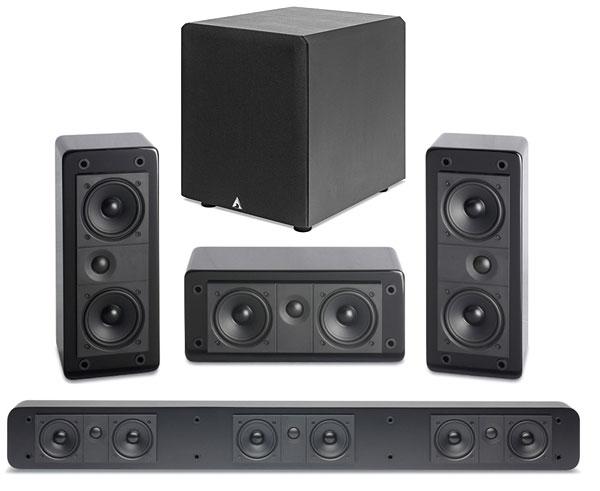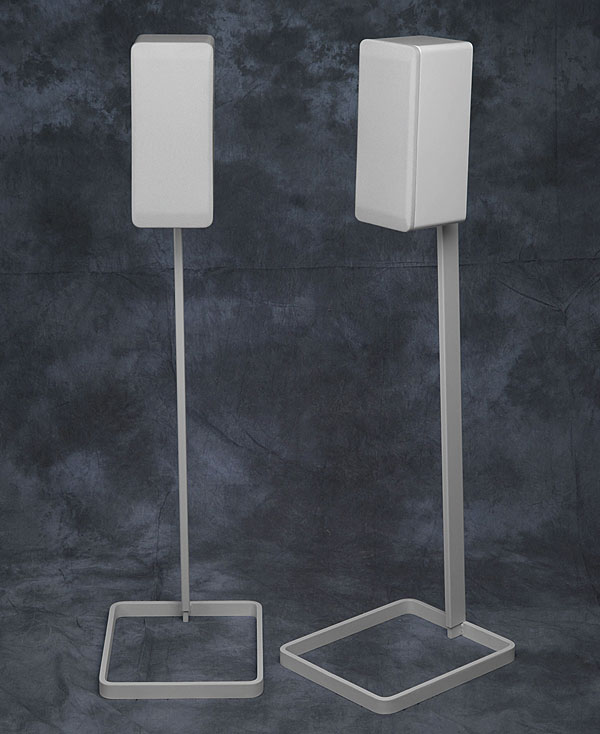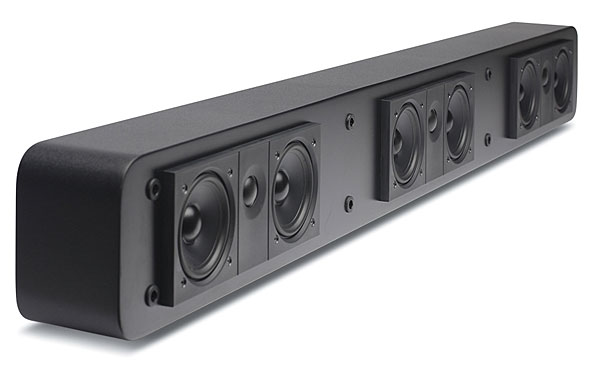Atlantic Technology FS3 and LCR3 Speaker System Review

AT A GLANCE
Plus
Slim-profile passive soundbar, or...
Compact LCRs in front, with...
One sub or two
Minus
AVR required for passive bar
Inherent limits of 8-inch sub
THE VERDICT
Whether configured with a three-channel soundbar up front or compact LCRs all around, this system delivers deeply satisfying performance for the price, with plenty of listening comfort.
How should your 5.1-channel system handle the three channels in front? You might use the traditional approach of three separate speakers. Then again, you might simply use a passive soundbar with left, center, and right drivers. We’ve reviewed both kinds of systems—but until now, we haven’t reviewed both options at once. In this Test Report, that’s just what we’re going to do. We’ll start with Atlantic Technology’s new FS3 soundbar in the front and two voice-matched LCR3 satellites in the surround positions. Then we’ll swap out the soundbar for three more satellites to see what that brings to the table. To make it even more interesting, we’ll start with a single 8-inch SB-900 subwoofer, then contemplate the advantages of adding a second one.
System pricing is $1,550 for one FS3, two LCR3s, and one SB-900. Adding the second sub raises the cost to $1,900. For five LCR3s, the total is $1,725 with one sub or $2,075 with two.
I’m writing this introduction before starting the listening demos. Here’s what I expect to happen: The soundbar would have a more solid, but narrower, front soundstage. Substituting three speakers for the bar should expand the soundstage. It would also provide more flexibility in placement, if that were a factor. Adding the second sub would improve the evenness of bass coverage, extending good bass response to more locations in the room. As for what the speakers would actually sound like—their balance of frequencies, dynamics, coloration, and all the tangibles and intangibles that add up to listenability—I’m at square one. Let’s explore.
Two Peas in Different Pods
The FS3 is a passive soundbar with no internal amplifier or surround processing. You connect it to a receiver as the front left, center, and right speakers. At 42 inches wide, it’s recommended for TVs of 42 to 65 inches (measured diagonally). As an option, consider adding Atlantic’s Shelf-2405 ($119), which allows above-screen placement of a soundbar (or center speaker) by attaching to the top of a flat-screen TV. A lip on the front of the shelf keeps the speaker from sliding off, and the clamps have rubber bumpers to protect the TV. Note that this might not work for thin-bezel TVs. The FS3 soundbar is available in matte or gloss black.
The LCR3 is a tall, slender satellite speaker that can be used for any channel in the system. As noted, for this review, I used two different 5.1-channel configurations, first with two LCR3s in the surround positions and then with five all around. Available finishes are gloss black or white. Gloss black is the only finish the LCR3 sat has in common with the FS3 bar.

The FS3 and LCR3 have much else in common, including their driver arrays. They share both a 0.75-inch silk-dome tweeter and a 3.5-inch CPP (composite polypropylene-paper) cone woofer. The satellite has one tweeter flanked by two of the woofers; the soundbar has that woofer-tweeter-woofer array in triplicate, just like three horizontal LCR3s in a larger and shallower enclosure. The tweeter is positioned slightly upward in the bar or off to one side in the vertical satellite. The asymmetrical placement helps to distribute the frequencies at which baffle edge diffraction occurs. Both the bar and satellite have sealed fiberboard enclosures and are equipped with sturdy cylindrical, all-metal, spring-loaded binding posts and dual keyhole mounts; the satellite adds a 1/4-20 threaded insert. Both have a nominal impedance of 6 ohms, rated sensitivity of 88 decibels, power handling of 10 to 125 watts RMS, and rated frequency response of 100 hertz to 20 kilohertz ±3 dB (I picked a sub crossover of 100 Hz in the receiver). See our Test Bench for independent measurements.
A key design feature of both the soundbar and satellite is the plate on which the drivers are mounted. It’s made of ABS—a tough, stiff plastic—with gaskets around the tweeter and both above and beneath the woofer, and it sits proud of the cabinet face. When the grille snaps on with its plastic pins, the plate fits into a cutout in the grille frame. This prevents the output of the drivers from reflecting off the skeleton of the grille. As Atlantic puts it, the drivers “see” into the room without obstruction.
The SB-900 is a front-firing sub. It has an 8-inch mineral-filled polypropylene cone driver with a 1.5-inch voice coil, a large unflared port in the same plane as the driver, and a 125-watt RMS amp. The speaker-level ins and outs are cheap wire clips, not my favorite termination, but most users will connect the LFE-in RCA jack to the receiver’s sub-out anyway. Atlantic claims for the sub something called CFT, or clear filter technology, which is said to use active circuitry to reduce enclosure-generated distortion. The correction is built into the EQ—which many subs have in one form or another—and Atlantic says it works better than the limiters and feedback loops employed by other manufacturers. Associated equipment included a Pioneer Elite VSX-53 A/V receiver, Oppo BDP-83SE universal disc player, Micro Seiki BL-21 turntable, Shure V15VxMR/N97XE cartridge, and the phono stage of a Denon PRA-S10 preamp.
Act I: Bar and Sats
The first configuration was the FS3 soundbar in front, two LCR3 satellites in the surround positions, and one SB-900 subwoofer. This created a soundfield that was narrow in front and wide in back.
“Smooth” was the first word that came to mind. While the FS3’s top end was far from anesthetized—in fact, it could still sound pretty zingy when content so demanded—it also easily sidestepped glare, grit, and harshness. Its voicing was never enough, in itself, to induce discomfort, and it held up at moderately high volumes. The LCR3’s voicing and performance in the surround positions were consistent with the FS3’s. The bar’s and satellites’ 3.5-inch drivers handed off neatly to the SB-900 sub’s 8-inch driver. The compact sub didn’t exactly shake the floor, but it produced clean tones without bloating or aggravating my room’s inherent standing wave in any noticeable way.

I’ve started a binge on Game of Thrones with the Blu-ray release of seasons 1 and 2 in Dolby Atmos. While Atmos’ addition of height channels gets the most attention, this object-oriented surround format can also remap a soundtrack to any system configuration—in this case, 5.1. The disc menu provided a choice of Atmos, Dolby Digital 5.1, and the usual language and commentary tracks. The Oppo player’s audio display also provided Dolby Digital but labeled the Atmos soundtrack as Dolby TrueHD 5.1 (TrueHD is the default audio codec for Atmos), and I chose that option. As I wrote in a blog called “Is 5.1 Obsolete?” about a year ago, “most of the fundamental truths of surround sound are present in a 5.1 system: a center channel to anchor dialogue, a soundfield that reaches to the four corners of the room, a subwoofer to firm up bass.”
My Game began with season 1, episode 1: “Winter Is Coming.” From the opening rumble of castle gates to the wealth of outdoor soundscapes—chuckling brook, distant thunder, or just the quiet movement of wind—the perfectly matched drivers and voicing of the bar and sats built a solid 5.1-channel soundfield that was somewhat narrow in front and wider in back. When I concentrated on the bar’s lack of width, I noticed it. But once I let down my guard, I was surprised to find my brain processing the trapezoidal soundfield to make me believe I was in wide open spaces. Sitting between the more widely spaced surround speakers—in my usual setup, side-surrounds—distracted me from the bar’s limited soundstage width much of the time.





























































